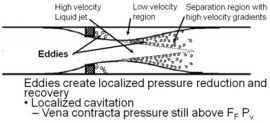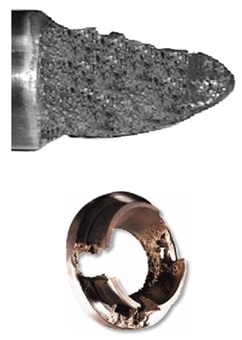Resources
Noise from Cavitation: Bad for Control Valves and Equipment
Submitted by Jon Monsen and Peter Jessee // Valve Magazine
Negative Effects on Control Valves & Equipment
Along with degraded control capability and rapid deteriation of the control valve itself, valve generated cavitation can cause serious damage to the piping system in which it occurs. Most of this damage is caused by vibrational noise energy, accelerated corrosion, and process contamination.
The high noise levels associated with cavitation reflect the large-amplitude vibrations generated by the formation and collapse of vapor bubbles near and downstream of the vena contracta.
 While this normally occurs within the valve body in globe and rotary plug valves, it can actually occur in the piping downstream of a short, high-recovery valve like wafer-body segment (V) ball valves, large ball valves and especially butterfly valves. When these valves are miss-applied in a location prone to cavitation, it is not uncommon for the piping downstream of the valve to be covered with weld-repaired leaks, or for this section of pipe to be frequently replaced as it fails.
While this normally occurs within the valve body in globe and rotary plug valves, it can actually occur in the piping downstream of a short, high-recovery valve like wafer-body segment (V) ball valves, large ball valves and especially butterfly valves. When these valves are miss-applied in a location prone to cavitation, it is not uncommon for the piping downstream of the valve to be covered with weld-repaired leaks, or for this section of pipe to be frequently replaced as it fails.
Regardless of whether the cavitation occurs inside or downstream of the valve, equipment downstream of the cavitation zone can see extensive damage. The large-amplitude vibrations can excite oscillatory failure in thin diaphragms, springs, and small cross-section or cantilevered structures. Frequent points of failure are found in instrumentation such as pressure gauges and transmitters, thermowells, flow meters, and sampling systems. Heat exchangers can fail prematurely from fatigue as the heat transfer fins oscillate due to vibration. Check valves, actuators, positioners and switches that contain springs will suffer accelerated wear, and mounting brackets, fasteners and couplings will loosen and fail because of the vibration. Unfortunately, hydrodynamic noise propagates extremely well in liquids and metal pipe walls, so it can take hundreds of pipe diameters for the noise to dampen to non-dangerous levels once it occurs.
 Fretting corrosion, which occurs between wearing surfaces exposed to vibration, is common near cavitating valves. This generates hard oxides which act as abrasives to accelerate wear between the wearing surfaces. Equipment affected includes isolation and check valves in addition to the control valve, pumps, rotating screens, samplers and any other rotating or sliding mechanism.
Fretting corrosion, which occurs between wearing surfaces exposed to vibration, is common near cavitating valves. This generates hard oxides which act as abrasives to accelerate wear between the wearing surfaces. Equipment affected includes isolation and check valves in addition to the control valve, pumps, rotating screens, samplers and any other rotating or sliding mechanism.
The high-amplitude vibrations also microscopically flex the metal valve parts and pipe walls, encouraging grain-boundary cracking and corrosion. The solid particles and corrosion chemical by-products released represent potential contaminants to the process. For instance, if the process is a RODI water treatment loop, a food or pharmaceutical process, a paper pulp bleaching line, or any number of high-purity processes, these contaminants degrade the quality of the product.
Predicting & Eliminating Cavitation Damage
Especially with rotary valves, the prediction of damaging levels of cavitation is more complex than simply calculating the choked flow pressure drop. Experience has shown that there are likely to be areas of localized vaporization and vapor bubble collapse before the pressure in the main flow stream drops to the vapor pressure of the liquid. Some valve manufacturers predict the beginning of cavitation damage by defining an incipient damage pressure drop. One valve manufacturer’s method of predicting the beginning of cavitation damage is based on the fact that it is vapor bubble collapse that causes both cavitation damage and noise. This manufacturer has determined that if calculated noise levels are below the following limits, significant cavitation damage will be avoided.
Pressure drop staging means that the valve is designed to have two or more throttling points in series, so that instead of taking the entire pressure drop in a single step, it is taken in several smaller steps. Smaller individual pressure drops can prevent the pressure at the vena contracta (the point where the velocity is the highest and the local pressure is the lowest) from dropping to the liquid’s vapor pressure, thus eliminating cavitation. Improved cavitation resistance can be obtained by combining flow division and pressure drop staging in the same valve.
Modifying the process to locate the control valve where the pressure at the valve inlet is higher (such as farther upstream or at a lower elevation) can sometimes eliminate a cavitation problem. Also, locating the control valve at a location where the liquid temperature, and thus the vapor pressure, is lower (such as the low temperature side of a heat exchanger) can help eliminate a cavitation problem.
Summary
As has been shown, cavitation in control valves does more than just degrade valve performance and damage the valve. Downstream piping and equipment is also at risk, and process contamination can ruin the product that the process is intended to make. Predicting cavitation and taking steps to eliminate it is the only way to avoid a costly and ongoing problem.
Read the full article from Valve Magazine website
Along with degraded control capability and rapid deteriation of the control valve itself, valve generated cavitation can cause serious damage to the piping system in which it occurs. Most of this damage is caused by vibrational noise energy, accelerated corrosion, and process contamination.
The high noise levels associated with cavitation reflect the large-amplitude vibrations generated by the formation and collapse of vapor bubbles near and downstream of the vena contracta.

Regardless of whether the cavitation occurs inside or downstream of the valve, equipment downstream of the cavitation zone can see extensive damage. The large-amplitude vibrations can excite oscillatory failure in thin diaphragms, springs, and small cross-section or cantilevered structures. Frequent points of failure are found in instrumentation such as pressure gauges and transmitters, thermowells, flow meters, and sampling systems. Heat exchangers can fail prematurely from fatigue as the heat transfer fins oscillate due to vibration. Check valves, actuators, positioners and switches that contain springs will suffer accelerated wear, and mounting brackets, fasteners and couplings will loosen and fail because of the vibration. Unfortunately, hydrodynamic noise propagates extremely well in liquids and metal pipe walls, so it can take hundreds of pipe diameters for the noise to dampen to non-dangerous levels once it occurs.

The high-amplitude vibrations also microscopically flex the metal valve parts and pipe walls, encouraging grain-boundary cracking and corrosion. The solid particles and corrosion chemical by-products released represent potential contaminants to the process. For instance, if the process is a RODI water treatment loop, a food or pharmaceutical process, a paper pulp bleaching line, or any number of high-purity processes, these contaminants degrade the quality of the product.
Predicting & Eliminating Cavitation Damage
Especially with rotary valves, the prediction of damaging levels of cavitation is more complex than simply calculating the choked flow pressure drop. Experience has shown that there are likely to be areas of localized vaporization and vapor bubble collapse before the pressure in the main flow stream drops to the vapor pressure of the liquid. Some valve manufacturers predict the beginning of cavitation damage by defining an incipient damage pressure drop. One valve manufacturer’s method of predicting the beginning of cavitation damage is based on the fact that it is vapor bubble collapse that causes both cavitation damage and noise. This manufacturer has determined that if calculated noise levels are below the following limits, significant cavitation damage will be avoided.
- Up to 3 inch valve size – 80 decibels (dBA)
- 4-6 inch valve size – 85 dBA
- 8-14 inch valve size – 90 dBA
- 16 inch and larger valve size – 95 dBA
Pressure drop staging means that the valve is designed to have two or more throttling points in series, so that instead of taking the entire pressure drop in a single step, it is taken in several smaller steps. Smaller individual pressure drops can prevent the pressure at the vena contracta (the point where the velocity is the highest and the local pressure is the lowest) from dropping to the liquid’s vapor pressure, thus eliminating cavitation. Improved cavitation resistance can be obtained by combining flow division and pressure drop staging in the same valve.
Modifying the process to locate the control valve where the pressure at the valve inlet is higher (such as farther upstream or at a lower elevation) can sometimes eliminate a cavitation problem. Also, locating the control valve at a location where the liquid temperature, and thus the vapor pressure, is lower (such as the low temperature side of a heat exchanger) can help eliminate a cavitation problem.
Summary
As has been shown, cavitation in control valves does more than just degrade valve performance and damage the valve. Downstream piping and equipment is also at risk, and process contamination can ruin the product that the process is intended to make. Predicting cavitation and taking steps to eliminate it is the only way to avoid a costly and ongoing problem.
Read the full article from Valve Magazine website
A lesson for me is that I need to involve you earlier in the program.
You were tireless in your support and it will not be forgotten!
Latest from Valin's Blog
The NIST Chemistry WebBook contains a great deal of information regarding the properties of a broad range of chemicals and is helpful for those who deal with chemical processes.In this article, Jon Monsen has outlined the procedure for finding the actual density of a gas using the WebBook.
